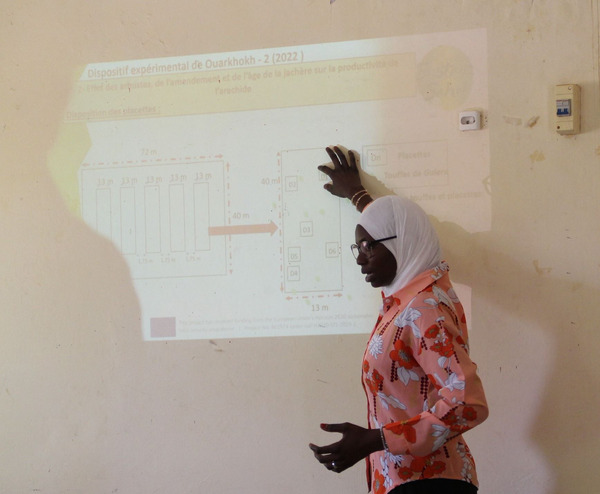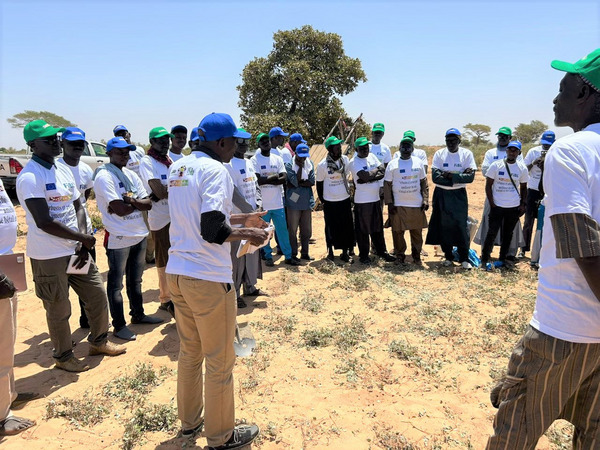The dissemination days started in Ouarkhokh, where the producers massively responded to the invitation. In Ouarkhokh as in Niakhar, the days began with the presentation of the SustainSahel project and the importance of innovative platforms (IP) in its implementation. The PI is an assembly of producers that allows researchers to discuss the choice of innovative techniques. Michael Diedhiou of the National Council for Concertation and Rural Cooperation (CNCR) explains: «Before applying a technique in the demonstration fields, the researchers first discuss with the members of the PI, made up of amonst others producers, a member of the town hall of the commune and of researcherss. It is a way for producers to provide their point of view on innovative techniques, seeds, but also to list their needs.»
Then, WP4 and WP6 shared the results of experiments developed through their research in demonstration fields and with livestock. During these two years, WP6 mainly carried out its research in Ouarkhokh, focusing especially on the effectiveness of ligneous plants in the diet and health of livestock. Aminata Béye, expert in agroforestry, presented the results: «In Ouarkhokh, the species most used by ruminants are Balanite Aegyptiaca and Acacia Albida. These are species that we are studying to assess their effects on livestock health and nutrition. We have found that the effectiveness of dewormers used by some breeders, such as Albendazole and Ivermectin, is suboptimal. For now, we offer them them woody fodder as an alternative this year, in order to obtain better results than the expensive chemicals that they currently use.»
WP6 also presented a platform: the tool for calculating feed rations for ruminants based on woody fodder, which was developed to help breeders quantify the feed for their livestock. This platform will allow breeders to get answers to questions they may have. The tool informs them in particular about adequate feed rations for their livestock, the trees and shrubs they can use to improve diet and health of the animals, as well as their production of organic manure that can be used by farmers. A student position will be put in place to support the farmers with using the platform.
After the presentation of the results, the demonstrations took place. But before that, communication materials, such as T-shirts, caps and bags in the colors of Sustain Sahel were distributed to the producers.
In Ouarkhokh, demonstrations focused on recommended practices regarding quantities and methods for organic matter application, such as manure and Guiera Senegalensis residues, as well as mulching methods. In Niakhar, the demonstrations also covered how and how much organic matter (manure and Guiera Senegalensis residues) was applied. The producers carried out the demonstrations with the support of the research team, explaining the different steps in the local language, which allowed their peers to better understand and learn the methods and techniques more quickly.
Feedback from the producers
During the discussions the producers were able to ask questions. In turn, the farmers informed about effectiveness of innovative techniques they have already implemented. Demba Yoro Bâ, a breeder from the village of Gorel Thiang in the commune of Ouarkhokh, emphasized the usefulness of the shrubs for his livestock: «The Sustain Sahel project is very beneficial for us, especially for our livestock. We have been shown that with certain shrubs we can fight certain diseases that affect our livestock, especially small ruminants.»
Bassirou Fall, a producer from Niakhar, spoke about the benefits of certain shrubs he uses: «The Guiera is as good for our land as it is for our cattle. I start using it during the dry season by taking the leaves that I scatter over my plot and then mix them into the soil. Then, I wait for the sowing period, and I already know that I will have a good harvest because I have prepared my plot well. Guiera is also very effective for livestock, it is an excellent dewormer.» The next step for th producers is the dissemination of the techniques within their community. Demba Yoro says: «This project is an opportunity for us, and for that alone, we need to get more involved in spreading these innovative techniques. I pledge to do so with my community.» Bassirou Fall adds: «We learned a lot thanks to this project, my life has changed a lot. I feel that my land is in good health and I have fruitful harvests. I have to share my knowledge with my classmates. I will take the time necessary to teach them the different steps.»
The following was suggested for efficient dissemination of techniques:
- Organize talks where the producers can show the Access Agriculture videos that we shared with them and through memory cards distributed during the dissemination days last September. In this way, they will be able to better explain the techniques and their uses to their colleagues.
- Invite their comrades to show them the methods they apply in their field.
During the dissemination days, it was also necessary to take care of the plants distributed during the last days of dissemination, to allow the comunity of Niakhar and Ouarkhokh to afforest their stands. However, the fact is that some plants did not survive and others were poorly maintained. To remedy this, the producers offered to collaborate with the town halls to find spaces and involve the students in the reforestation of their schools, in order to increase green spaces in Ouarkhokh and Niakhar.
From now on, the producers will take charge of the demonstration fields and will continue to practice the treatments. However, they will still receive advice, support and help from the researchers.
Written by: Ndéye Fatim Lo, Assistant in charge of communication, CSE centre de suivie écologique
Further information
Weblinks
Centre de Suivi Ecologique (CSE): Homepage




 tap and then scroll down to the Add to Home Screen command.
tap and then scroll down to the Add to Home Screen command.